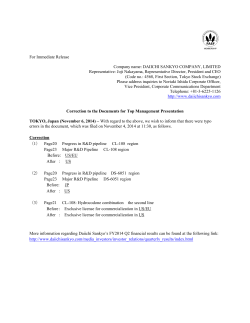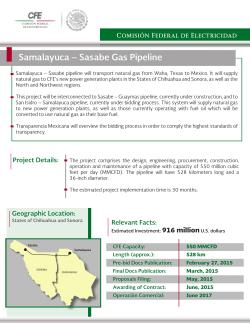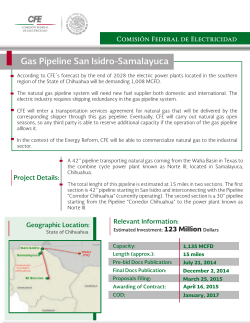
ChadâCameroon pipeline
Chapter 16.qxp 6/4/07 7:56 PM Page 218 Chapter 16 Chad–Cameroon pipeline Type of project Development of oilfield and construction of oil pipeline. Country Chad and Cameroon. Distinctive features • • • • • • • Largest construction project in sub-Saharan Africa outside South Africa. Environmental concerns. Lengthy due diligence and public consultation process. Poverty and corruption in both countries. Significant economic opportunity for Chad. First syndicated loan for Chad. First-of-its-kind contractual agreement to direct oil well and pipeline revenues to support economic and social development in Chad. • World Bank financing at commercial rates to enable Chad and Cameroon to invest equity in the project through their national pipeline companies. • Multilateral agency participation required by both sponsors and other lenders. Description of financing The total project cost is US$3.7 billion: US$1.7 billion for oilfield development, and US$2 billion for pipeline and marine facilities. The oilfield development was financed by the sponsors, and the pipeline and marine facilities were project-financed. The project financing comprised: • • • • • 218 US$500 million in equity from sponsors; US$100 million in equity from the governments of Chad and Cameroon; US$100 million as an ‘A’ loan from the International Finance Corporation (IFC); US$100 million as a ‘B’ loan from the IFC, with funds provided by commercial banks; US$200 million as a commercial bank loan with 100 per cent cover from the Export Import Bank of the United States; Chapter 16.qxp 6/4/07 7:56 PM Page 219 CHAD–CAMEROON PIPELINE • US$200 million as a commercial bank loan with 95 per cent cover from Compagnie Française d’Assurance pour le Commerce Extérieur (Coface); and • a US$400 million bond. In addition: • The World Bank made a US$53.4 million loan to Cameroon and a US$39.5 million loan to Chad to finance the governments’ equity share in the project. • The European Investment Bank (EIB) made conditional loans from its risk capital resources raised in the capital markets of €35.7 million (US$32.8 million) to Cameroon, €20.2 million (US$18.6 million) to Chad and €88 million (US$80.9 million) to certain members of the consortium to fund their participations in Tchad Oil Transport Company (TOTCO) and Cameroon Oil Transport Company (COTCO), 1 the two pipeline companies (described below). All of the senior debt for the pipeline project was provided to TOTCO and COTCO. • Separately from but in relation to the project financing, the International Development Association, part of the World Bank Group, made a US$23.7 million loan to Chad and a US$5.8 million loan to Cameroon. These loans were intended to strengthen both countries’ capabilities for environmental management and oversight of the oil industry. Project summary2 The project has two components: • • the upstream or field system, which entails drilling about 300 oil wells to develop the Kome, Miandoum and Bolobo oil fields in the Doba Basin, southwest of the city of Doba in southern Chad, over a 30-year concession period; and the pipeline system, which entails construction of a 30-inch pipeline, with three pumping stations along the route and a monitoring system to detect leaks, running 1,070 kilometres (km) from the oilfields to a floating storage vessel moored 12 km offshore from Kribi on the Atlantic coast of Cameroon. Most of the pipeline will run 1 metre under the soil in Cameroon. Oil reserves are expected to last for 25 to 30 years. At the height of production the project is expected to produce 255,000 barrels per day of heavy viscous oil that will have to be lifted by electric pumps because of the absence of significant natural gas deposits. Project construction began in 2000 and is scheduled to be completed in 2004. The project will employ up to 7,000 people during construction, and between 500 and 800 during operation. Most of the skilled workers employed are foreigners, but when the project reaches the operating stage about 80 per cent of the workforce will be citizens of Chad or Cameroon, with extensive training.3 The oilfield development was financed by the sponsors, while the pipeline and marine facilities were project-financed through sponsors’ equity, A/B loans from the IFC, additional 219 Chapter 16.qxp 6/4/07 7:56 PM Page 220 PIPELINES commercial bank financing with cover from export credit agencies (ECAs), and a bond. Multilateral agency participation was required for both the sponsors and the lenders to participate in the project. The project is expected to generate between US$9 billion and US$18 billion for the consortium, depending on oil prices. Over the 25-year course of the project the government of Chad is expected to earn about US$2 billion, equal to half its national budget, while the government of Cameroon is expected to earn about US$500 million, about 3 per cent of its 4 5 national budget. Affected communities are to receive about US$600,000. Background Sponsors The project sponsors and their respective ownership are as follows: Exxon Mobil (40 per cent), Petronas (35 per cent) and Chevron (25 per cent). Exxon Mobil is the project manager. Each of the three consortium partners is responsible for receiving, transporting, and selling its respective share of the oil. Shell and Elf Acquitaine were originally sponsors, through subsidiaries, but they sold their shares in 1999 after helping to find replacement sponsors. Elf Acquitaine’s reason for selling was believed to be a shifting of priorities after it was acquired in 1999 by the FrancoBelgian oil company Total Fina. In addition, because oil prices had recently fallen as low as US$10 per barrel, the projected returns for this and many other projects were not clearing their sponsors’ hurdles. Chevron had been a member of the Doba Basin consortium in the early 1990s, but it had sold its 17 per cent interest to Elf, reportedly because of concern over continuing civil wars 6 in Chad. Project structure The field system is owned and operated by Exxon Mobil, Petronas, and Chevron. Exxon is the project manager. The pipeline system is owned and operated by two joint venture companies, Tchad Oil Transport Company (TOTCO) and Cameroon Oil Transport Company (COTCO). The threemember oil consortium holds majority stakes in both pipeline companies, the government of Chad holds minority stakes in both, and the government of Cameroon holds a minority stake only in COTCO. Origins of the project Oil was first discovered in the Miandoum Field in the Doba Basin of Chad in 1974 by a consortium comprising Exxon, Chevron, Shell and Conoco. Conoco withdrew from the group in 1981 and, as mentioned above, Chevron sold its interest to Elf Acquitaine in 1993. Development was delayed for more than 20 years because of civil conflict, opposition by environmental groups, and wavering interest on the part of Shell and Elf. Discussions on a possible pipeline to ship the oil through Cameroon for export began in 1992, leading to a feasibility study. In 1993 the sponsors began public consultations in Chad and Cameroon, as well as preliminary discussions with financial sources such as the 220 Chapter 16.qxp 6/4/07 7:56 PM Page 221 CHAD–CAMEROON PIPELINE World Bank Group. They were reluctant to take the country risk without the participation of multilateral agencies. In January 1995 representatives of the Republic of Cameroon, the Republic of Chad, Esso Exploration and Production (an Exxon affiliate), Société Shell Tchadienne de Recherches et d’Exploration (a Shell affiliate), and Elf Hydrocarbures Tchad (an Elf affiliate) signed a framework agreement. The agreement addressed the key commercial, financial, legal and operational terms under which a pipeline company would be formed to construct and operate the Cameroon portion of the crude oil export system. Both Cameroon, through its National Hydrocarbons Corporation, and the Government of Chad were expected to have equity interests in the pipeline. The pipeline was part of a project concept that envisaged drilling about 300 wells in the Doba Basin to produce several hundred million barrels of oil. The oil would be sent to a central processing facility and then shipped through the pipeline. While negotiations were under way the governments of Libya, Nigeria and Sudan lobbied Chad in attempts to have the pipeline run through their respective territories. There was also competition among three port cities in Cameroon for the terminal site: Douala, the commercial capital; Victoria, a natural port in the southwest; and Kribi, located in President Paul Biya’s home province of Southern Cameroon. The selection of Kribi caused controversy because it required substantially more port development than Victoria would have. Later in 1995 the World Bank Group began to work with the sponsors on an extensive analysis and public consultation process, intended to determine whether it should play a role in the project financing. During this process the World Bank Group, the sponsors and the host governments sought the advice of 45 scientists and environmental engineers, hosted 145 meetings with 250 international nongovernmental organisations (NGOs) and held nearly 900 7 village meetings. The World Bank Group and the sponsors published the first draft of an Environmental Impact Assessment for public comment in June 1998 and a final version in June 1999. The study, 3,000 pages long and bound in 19 volumes, contained contingency plans for almost every conceivable aspect of the project, including waste management, environmental management, oil spills, regional development, indigenous peoples, community health, compensation and resettlement, cultural properties, and decommissioning. At this stage, after 18 months of analysis, the World Bank Group and the sponsors agreed to a change in the proposed right of way for the pipeline. It would now be buried, rather than above ground, and would follow the existing infrastructure for most of its route. Although a maximum of 150 families would be displaced in the oilfield region, nobody along the pipeline route would have to be resettled. Construction could interrupt farmers’ access to their land for a brief period, but they would be compensated for lost income and lost fruit trees. The final route would comply with the World Bank Group’s safeguard policies on environmental assessments, natural habitats, indigenous peoples, cultural property, resettlement and forests. Two new national parks, each about 5,000 square km in area, would be created and managed for better conservation of biodiversity in the areas affected. To address the issue of sustainability the World Bank Group established capacity building programs in Chad and Cameroon, designed to develop the fiscal, legal, regulatory and managerial infrastructure needed to develop the oil industry and to minimise the adverse impact of the project. To ensure that the government of Chad directed its oil revenues in the manner agreed the World Bank Group proposed a novel ‘Revenue Management Plan’. 221 Chapter 16.qxp 6/4/07 7:56 PM Page 222 PIPELINES The Revenue Management Plan The World Bank Group had learned from previous experience that a large influx of oil revenues could lead to economic distortion, corruption and waste in a less developed country. To prevent history from repeating itself, and to ensure that the oil revenues were directed towards key development and poverty-reduction programmes, the World Bank Group and the government of Chad agreed on a method for distributing the estimated US$1.8 billion cash flow that Chad would receive in the form of income taxes, royalties and dividends.8 The plan became the basis of a law, enacted by Chad’s legislature in December 1998, under which: • • • 10 per cent of the royalties and revenues would be held in trust to finance poverty reduction programmes for future generations; 76.5 per cent would be devoted to education, health, social services, rural development, infrastructure, environmental management and water resource management; and 13.5 per cent would be earmarked for regional development in the oil-producing area over and above that region’s share of national spending. There would be annual published audits of the oil accounts and regular public expenditure reviews, not only by the World Bank Group but also by a ‘watchdog’ commission of five official and four independent members in Chad. Environmental and social concerns The World Bank Group viewed the project as an unparalleled opportunity to improve economic prospects of Chad, one of the poorest countries in the world, at a time when it could not afford to provide the minimal level of services to ensure a decent life for its people. If the project in its current form was not approved the sponsors would pursue opportunities elsewhere and there was no telling when they might return to Chad. Soon after plans for the pipeline became known, however, various environmental and other NGOs in Chad, in Cameroon and around the world began to lobby against the project because of alleged environmental, social, and political problems, including the following. • • • • • • • • 222 The project would benefit the corrupt regimes in the two countries more than their impoverished peoples. The governments did not have the ability to manage the oil revenues. The pipeline corridor would cut through two national parks and through thick tropical forest in Southern Cameroon, creating population, logging and other pressures. The habitat of the Bagyeli people (also known as Pygmies) would be compromised Animal species at risk included black rhinoceroses, elephants, chimpanzees and gorillas. The potential for leaks and spills threatened farmland in Chad, rivers in Cameroon and coastal fishing resources; guarantees for clean-up in the event of such spills were inadequate; and a US$1 million amount set aside for such emergencies was far from adequate. The proposed compensation for peasants who would lose their land (US$10 for a mango tree, US$36 for a banana tree and 4–5 US cents for each square metre of sorghum or millet field lost) was inadequate. Local communities and NGOs had not been sufficiently included in the planning process. Many prominent environmental NGOs participated in the campaign, including Friends Chapter 16.qxp 6/4/07 7:56 PM Page 223 CHAD–CAMEROON PIPELINE of the Earth, Greenpeace, the German Greens, the Environmental Defense Fund and the Sierra Club. In 1998 some 86 environment, development, human rights and religious NGOs gathered petitions online, and sent a joint open letter to ask the World Bank Group’s President, James Wolfensohn, to suspend the Bank’s participation in the project until respect for human rights and compliance with the World Bank Group’s environmental policies could be guaranteed.9 In 1999 27 US Senators and Congressmen asked Wolfensohn to ensure that the project did not proceed until civil and human rights concerns in both countries had been addressed, and there was evidence of the political will to implement environmental protection measures. At about the same time Idriss Déby, President of Chad, flew to the United States to appeal for support for the project. In the spring of 2000 demonstrators in the streets of Washington, DC, during IMF and World Bank meetings cited the project and its alleged threat to the Bagyeli people as a symbol of the dangers of globalisation. That year a group of environmental NGOs sent a letter to the EIB asking it to pull out of its financing for the Chad–Cameroon project, and the European Parliament passed a resolution demanding that the EIB not approve its proposed loans until Chad lived up to its agreement to improve its environmental and human rights legislation. There were reactions against the protests in both Chad and Cameroon. Although Chad guarantees freedom of expression, a member of its legislature was imprisoned after speaking out against the project.10 Despite the protests, in June 2000 the World Bank Group received approval from its board of directors to go ahead with the proposed financing. The agency was convinced that this unique opportunity to boost Chad’s economy, and to benefit Cameroon’s as well, outweighed the social and environmental risks. In announcing the approval it emphasised the safeguards that had been put in place to ensure that neither Chad nor Cameroon misused its oil revenues, and that environmental and human rights concerns were addressed. In February 2001 the World Bank appointed an international advisory group with responsibility for identifying problems in the use of public revenues, the adequacy of civil society participation, and the environmental and social impact of the project. The six-member committee, chaired by a former prime minister of Senegal, would be charged with visiting Chad and Cameroon twice a year, and making periodic reports to the World Bank’s President and Board of Directors. Members of international environmental NGOs questioned how well the group could monitor what was really going on by visiting the two countries only twice a year. In 2001, several months after the World Bank had approved its financing, President Déby of Chad fuelled further controversy over the project by approving the spending of US$4 million, from a US$25 million bonus paid by the project sponsors, on arms purchases. Risk analysis Construction risk Any construction project of this size runs the risk of cost overrun and schedule delay. However, no new technology is involved and the terrain over which the pipeline is being constructed, while varied, poses fewer challenges than for other pipelines, in countries such as Colombia, that have crossed mountain ranges. 223 Chapter 16.qxp 6/4/07 7:56 PM Page 224 PIPELINES Country risk One of the principal risks of the project relates to the economies and politics in Chad and Cameroon. In 2000 Chad, which gained independence from France in 1960, had a population of 7.5 million, per-capita GDP of US$215 and per-capita exports of about US$27. About 80 per cent of its people live on less than US$1.00 per day. It has a high infant mortality rate, limited access to social services and poor levels of nutrition. Chad is three times the size of California, but has only a few hundred kilometres of paved roads. Ninety per cent of the country is desert or semiarid. Most of the economy is based on subsistence farming. Cotton is the only significant export. Chad’s narrow economic base and lack of skilled people have limited the opportunities for growth in most sectors. Economic growth has been hampered by intermittent civil war since 1980, when rebels from the Muslim north seized power from government forces in the south. President Déby, a French-trained army officer, came to power through a coup in 1990. He has a reputation as a warlord, and organisations such as Amnesty International and the US State Department have criticised his regime for extrajudicial killings, as well as arbitrary arrests and detentions. With a population of 14.9 million, per-capita GDP of US$589 and annual per-capita exports of about US$137 in 1999, Cameroon is ahead of Chad, but is still among the 49 countries classified as ‘low income’ by the World Bank Group. Cameroon’s economy has been based on exports of agricultural commodities and oil. In recent years the need for imports has been reduced by the development of new economic activities, including agriculture-based manufacturing of, for instance, fruit juices, dairy products, beer and soap). Cameroon was ranked by the Berlin-based NGO Transparency International as the world’s most corrupt country in 1998 and 1999, and among the eight most corrupt countries in the following two years. The organisation defines corruption as the abuse of public office for private gain, as seen by businesspeople, business risk analysts and the general public. President Biya of Cameroon has been criticised because of his regime’s poor human rights record. Environmental risk The project has environmental risk, which the sponsors and lenders consider to be manageable, but equally important, it has had perceived environmental risk. As discussed above, one of the principal challenges for the sponsors and the World Bank Group was to convince environmental NGOs throughout the world that the project would not result in unacceptable environmental damage, or excessive risks to the natural life and indigenous people of the region. How the financing was arranged The commercial bank, IFC and ECA portion of the financing closed in June 2001. ABN AMRO and Credit Agricole Indosuez, the lead arrangers, offered pro rata participations, ranging from US$35 million to US$50 million, in the three syndicated commercial bank tranches to the arrangers and co-arrangers, which earned fees of 100 basis points. Arrangers were Bayerische Hypo and Vereinsbank, BNP Paribas, Dexia Credit Local, Fortis Bank, ING Bank, IntesaBCI SpA, KBC Bank, Natexis Banque Populaire, Standard Chartered Bank, and Westdeutsche Landesbank. Co-arrangers were Bank of Scotland, Citibank, Credit Lyonnais, Dai-Ichi Kangyo Bank, Erste Bank and Société Générale.11 224 Chapter 16.qxp 6/4/07 7:56 PM Page 225 CHAD–CAMEROON PIPELINE Recent developments Developmental drilling and laying of the pipeline began in late 2001. By the spring of 2002 there were 5,000 people employed in the project. It was expected that construction of the pipeline would be completed, and that production from the Doba Basin would begin, by early 2004. The IMF estimated that Chad’s economy grew at 8.9 per cent in 2001, in comparison with 0.6 per cent in 2000, mainly because of acceleration in the oilfield pipeline project, but also because of structural reforms. The IMF predicted that the country’s economy would continue to grow in 2002, but it stressed the importance of implementing reforms and policies to better manage oil revenues, integrate the oil industry into the overall economy, develop nonoil activities and liberalise the cotton industry. Lessons learned Because of the political and economic risk in Chad and Cameroon the major oil company sponsors would not have gone ahead with the project without multilateral agency participation. By the same token, an organisation of the World Bank’s stature was required to make a convincing statement that environmental and social concerns of NGOs and other special interest groups would be addressed in a responsible manner. Project sponsors that want to involve the World Bank Group in future projects may have to accept some degree of revenue and environmental monitoring. Time will tell whether the international advisory group can be helpful to the World Bank in ensuring environmental compliance and proper disposition of revenues. The World Bank acknowledged that oil revenues had failed to benefit the people in other less developed countries, such as Nigeria, but decided that an unparalleled opportunity for the economy of Chad outweighed the social and environmental risks. With this project the World Bank Group hoped to set new standards for ethical financing in a difficult environment. 1 Williams, Annie, and Mark Castillo-Bernaus, ‘Chad Cameroon Pipeline Sets New Standards for African Project Finance’, International Financial Law Review, September 2001, p. 10. 2 This case study is based on The Chad–Cameroon Petroleum Development and Pipeline Project, Harvard Business School Case Study N9-202-010, 29 October 2001, prepared by Research Associate Carrie Ferman under the supervision of Professor Benjamin C. Esty, as well as a follow-up interview with Professor Esty and articles in the financial press. 3 Onishi, N., ‘The Perils of Plenty: A Special Report’, New York Times, 16 May 2001, p. 1. 4 Murphy, John, ‘Where Oil Flows, Future Holds Promise, Threat’, Baltimore Sun, 3 September 2000, p. 1. 5 Mutume, Gumisai, ‘Development: World Bank Blasted for Chad–Cameroon Pipeline’, Inter Press Service, 6 June 2000. 6 ‘Chad–Cameroon Pipeline on Track’, Hart’s Africa Oil and Gas, 19 April 2000. 7 Ferman and Esty, op. cit., p. 7. 8 Ibid. 9 De Giorgio, Emmanuelle Moors ‘Pipeline to Disaster?’, African Business, March 2000, p. 26. 10 Murphy, op. cit., p. 1. 11 ‘Chad–Cameroon Debt Signed’, Project Finance, July 2001, p. 10. 225
© Copyright 2025









